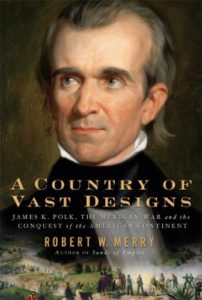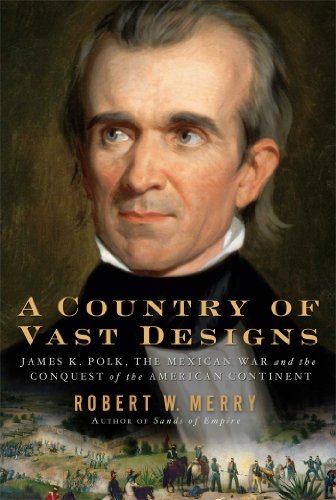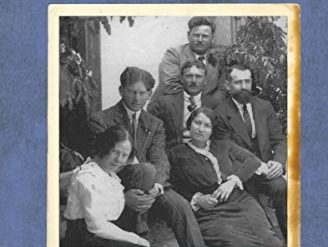
When we conjure up images of our greatest American Presidents, a handful of names invariably comes up: George Washington and Abraham Lincoln, of course; Thomas Jefferson and Franklin D. Roosevelt, too; perhaps Theodore Roosevelt as well. Today many of us would add one or more from among those who have served in the White House since World War II. However, most historians would say it’s too early to understand the impact of their actions. Virtually anything any President does these days seems important and far-reaching at the time. History may well decide otherwise. The history books can’t be reliably written until all the secret archives have been opened. But it can’t be said that we lack enough information about the man who started the Mexican-American War.
Estimated reading time: 7 minutes
A long black hole in our nation’s history
Professional historians aside, few of us are likely to identify any President who served between 1809, when Jefferson left office, until 1861, the year Lincoln moved into the White House. For the overwhelming majority of us, limited by the sketchy history classes of our youth, the middle of the nineteenth century was a black hole in our country’s Presidential history. (One possible exception is the controversial former general, Andrew Jackson, who served from 1829 to 1837. Many historians rank him among our greatest Presidents, and he often creeps into high school history textbooks, with or without a discussion of the blatant racism that drove him.)
A Country of Vast Designs: James K. Polk, the Mexican War, and the Conquest of the American Continent by Robert W. Merry (2009) 612 pages ★★★★★
A forgotten one-term President
It seems exceedingly unlikely that President James K. Polk would come to many minds as an example of the most important men who have served in the office. Yet a very strong case could be made that Polk’s single four-year term (1845-49) was, indeed, among the most consequential times in U.S. history — and that Polk himself was the prime mover. Robert W. Merry powerfully advances that argument in A Country of Vast Designs: James K. Polk, the Mexican War, and the Conquest of the American Continent.
Today, Americans take for granted that the United States is a continental power, its territory stretching uninterruptedly from the Atlantic to the Pacific. Of course, that was far from the case in the early years of the nation. Our territory was added piecemeal over nearly a century to the original 13 colonies. When President Jefferson took office in 1801, the U. S. consisted of just 16 states. American settlers had pushed only as far west as the Mississippi River.
Then came the vast Louisiana Purchase when Jefferson bought it from Napoleon in 1803. In 1819, when James Monroe was in the White House, the U.S. purchased Florida from Spain. Apart from Alaska, bought from Russia in 1967 during the Administration of the deservedly long-forgotten Andrew Johnson, and the acquisition of Hawaii by conquest in 1898 under William McKinley, only a sliver of territory in our Southwest (the Gadsden Purchase) came into U.S. possession in the second half of the 19th Century. James K. Polk added all the rest, including nearly all the Southwest and all the Northwest of today’s United States. Just as Jefferson had doubled the continental expanse of the country, Polk added another third.
When America expanded to the Pacific
It would no doubt come as a surprise to most Americans that a nearly forgotten one-term President played such a central role in what was then (and later) called the country’s “Manifest Destiny.” Most of the new territory, though technically purchased by treaty, was in reality the result of a war with Mexico engineered by President Polk. Following the Mexican-American War (1846-48), much of Texas, all of California, and nearly all the land between them, came into the possession of the United States. During those same few years, Polk drove a hard bargain with Great Britain and acquired the Oregon Territory as well, establishing at long last a secure western border with Canada. That enormous chunk of land encompasses the present-day states of Oregon, Washington, Idaho, and parts of Wyoming and Montana.
American politics in the mid-nineteenth century
American politics in the mid-nineteenth century was dominated by three contending forces: the Democratic Party of Andrew Jackson and Martin Van Buren, divided between increasingly combative Southern and Northern wings; and the Whig Party, which evolved into the Republican Party in the 185os. Though other issues captured popular attention, the one that hung over the country like a shroud was slavery. With each passing year, slavery loomed ever larger in the balance of political forces not just in Washington, DC, but throughout the nation.
A political career in the shadow of giants
James K. Polk’s political career unfolded in the shadow of giants. During the time he served as Speaker of the House and Governor of Tennessee, five other men loomed much larger in the national consciousness. Three United States Senators, Henry Clay, Daniel Webster, and James E. Calhoun, dominated the politics of the time along with former Presidents Andrew Jackson and Martin Van Buren. Jackson, a Tennessean like Polk, was the younger man’s mentor and idol.
Clay was Polk’s greatest rival. Far better known than the former Governor of Tennessee, former President Martin Van Buren was considered certain to win the Democratic nomination for President in 1844. Instead, Polk — considered history’s first “dark horse” candidate for the White House — emerged the winner on the ninth ballot. He had intended to gain only the nomination for Vice President. Bitter sectional and personal rivalries among the leading candidates allowed Polk instead to emerge at the top of the ticket. As part of a bargain with his fellow Democrats, many of whom sought the office for themselves, Polk pledged not to run for reelection.
Four ambitious goals
As President, after winning a narrow victory over Henry Clay, the Whig Party’s candidate, Polk proved himself to be unimaginative, sometimes indecisive, a captive of the patronage politics of the times, and apparently humorless. However, Merry makes clear that Polk brought one supremely important attribute to the office: single-mindedness. At the outset, he set four ambitious goals as President, and he pursued them with nothing less than ferocity. Two involved finance (tariffs and banking), which raised great passion in business circles and on Wall Street. The other goals were to gain new territory for the U.S. in the Mexican Southwest and the bulk of the Northwestern territory disputed by Great Britain. (Polk fully expected he would have to go to war with Mexico, and he feared war with Britain as well.) Against all odds, Polk attained all four goals in the four short years of his Presidency.
When the U.S. and Mexico went to war
The dominant event of Polk’s Presidency was the Mexican-American War, which lasted for most of his time in office. Merry relates in detail how Polk maneuvered the country into war and prosecuted it successfully despite the incompetence and often insubordination of most of his senior generals. Again and again in the course of the conflict, Polk was also defied and undermined by his own Secretary of State — the future President James Buchanan — and breakaway diplomats.
Given the disarray of the Mexican government and the poor state of its military, the United States might otherwise well have won the war in months, as Polk had hoped. Instead, it dragged on, costing thousands of lives and the equivalent of hundreds of millions, if not billions, of today’s dollars. More importantly, it left a dark stain on American history and proved to be a harbinger of aggressive US military operations for nearly two centuries to come.
For related reading
You might also be interested in 13 good recent books about American foreign policy.
This is one of Top 10 nonfiction books about politics.
You may enjoy browsing through 20 top nonfiction books about history. And, for more good books on the history of the US, see Top 20 popular books for understanding American history.
And you can always find my most popular reviews, and the most recent ones, on the Home Page.



























